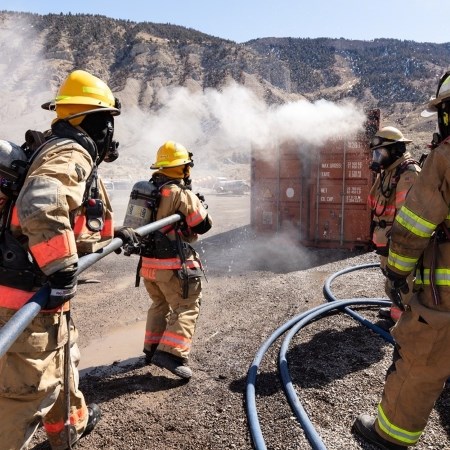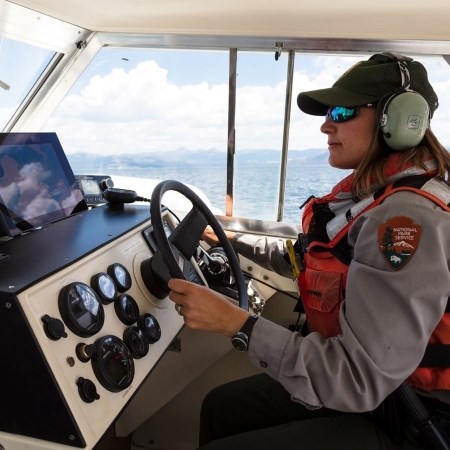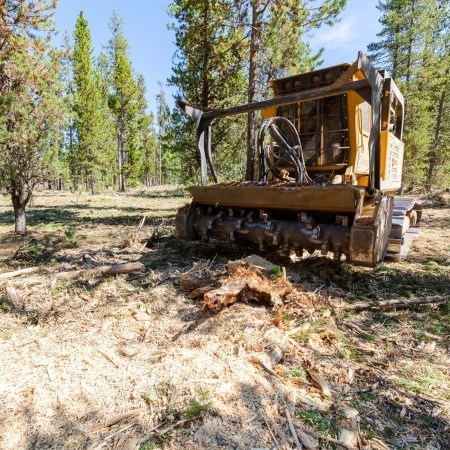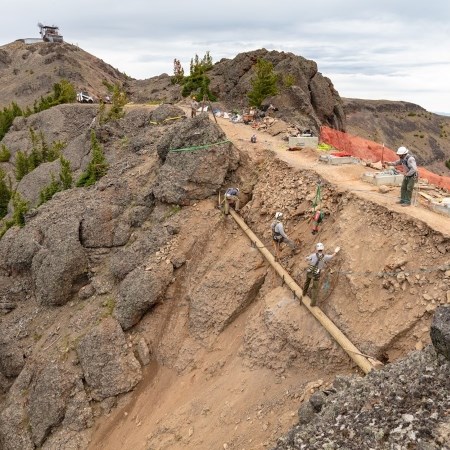Last updated: April 9, 2025
Article
Explore Careers: Yellowstone National Park 2019 #WhatWeDoWednesdays
Are you curious about the people who work in Yellowstone National Park?
We began highlighting the diversity of work done by Yellowstone employees in our #WhatWeDoWednesdays social media campaign. From studying archeological sites, to maintaining boardwalks, to predicting the next Old Faithful eruption, there are many types of positions that help preserve the park's natural and cultural resources for the enjoyment, education, and inspiration of this and future generations.
Learn more about the variety of work park employees accomplish below and view current open positions in Yellowstone.

Conducting Archeological Surveys
Beginning more than 11,000 years ago, people traveled through and used the Yellowstone area. As the park's infrastructure is updated to meet growing needs, archeologists and cultural resource specialists work to minimize impacts to historic resources. One way we accomplish this is by excavating "test units" to examine archeological deposits below the ground surface. "Archeological resources are invaluable in our understanding of people's lives before creation of the park, and also inform us about past climate and biotic change." - Archeologist Beth Horton, PhD
We use this knowledge to assess archeological sites for their significance or eligibility for listing on the National Register of Historic Places: the official list of U.S. buildings, districts, sites, structures, and objects worthy of preservation. "Seeing how our predecessors lived in the environment of Yellowstone over the millennia is fascinating; and protecting the evidence of their lives at archeological sites, historic buildings, and cultural landscapes is my calling." - Cultural Resource Specialist Tom James

Coordinating Research Permits
We're constantly trying to better understand the Greater Yellowstone Ecosystem through a variety of research. In addition to conducting our own studies, we also manage external research conducted in the park. Last year, our research permit coordinator, Annie Carlson, issued 142 permits to investigators from 31 states and 8 countries. This permitting process promotes the safety of the crews and protection of the resources they are here to study.
"There's no end to what scientists could discover in Yellowstone. I review many research proposals, with topics ranging from water chemistry to archaeology to butterflies. Meeting the scientists in the field and observing their methods is the best part. Every scientist views this ecosystem through their own unique lens." - Research Permit Coordinator Annie Carlson

Creating Defensible Spaces
Fire is an important part of Yellowstone's ecosystem, but we also work to protect human lives and the park's developed areas from fire.
"Many people don't realize there are nearly 2,000 structures in the park. In addition to actively managing wildfires, we proactively reduce fuel by creating defensible spaces around all of the structures in the park." - Fire Ecologist Becky Smith
In order to create a defensible space, hazard trees are trimmed or cut down, and usable wood is given to firewood permittees or district rangers for various projects. Leftover fuel is stacked and burned when the fire danger is low. These proactive measures minimize the fire intensity, should a wildfire threaten the area.

Curating Museum Collections
Did you know there are nearly 4.3 million Yellowstone-related items in the park's museum library and archive collections? Many of these objects are stored in the Yellowstone Heritage and Research Center (HRC) located in Gardiner, Montana. They range from microorganisms, historic photos, obsidian worked stone, former employee scrapbooks, and even historic vehicles. We offer public tours of the collection each Wednesday!
"It's an honor to work with such an extensive collection. My favorite pieces to show visitors are the wolf skulls of 7F and 2M: the first naturally formed pack in Yellowstone after the reintroduction." - HRC Curatorial Intern Ty

Delivering Park Supplies
Did you know that each summer we hand out a combined 1.6 million newspapers and maps? That's nearly 70 tons of information!
In order to keep our entrance stations and visitor centers stocked, our courier, Clark, drives around 7,000 miles during the summer to deliver packages and supplies to 30+ locations throughout the park.
"Yellowstone is an introduction to America's public lands for a lot of people. There's lots to learn to make the most out of their trip. I like to think my job helps facilitate that." - Park Courier Clark Dodd

Educating Youth
When summer ends and students return to school, Expedition Yellowstone education rangers like Heather help to grow tomorrow's stewards. Last year, with the help of generous donations through Yellowstone Forever, 68 teachers brought 1,943 students and chaperones to explore the geology, ecology, and human history of Yellowstone with rangers in the residential program.
"Kids love this program. For some, it's the first time they've been to the park. What better place to learn than the living laboratory of Yellowstone?" - Expedition Yellowstone Ranger Heather Basak

Emergency Dispatching
Did you know if you dial 9-1-1 when you're in the park, the call is answered by the Yellowstone Interagency Communication Center?
In addition to managing eight phone lines, employees like Kaelyn also monitor radio traffic. Between the phones and radio, the Communication Center handles over 25,000 calls each year.
"In addition to Yellowstone, our operation provides 9-1-1 services to three local communities and dispatch services to nine agencies outside the park. Visitors are our eyes and ears in the park. If you see something that requires police, fire, or medical services, don't hesitate to dial 9-1-1." - Center Manager Kaelyn Johnson

Extinguishing Structural Fires
Did you know Yellowstone has a structural fire department?
With over 3 million square feet of structures, including 800 buildings on the National Register of Historic Places, there's no shortage of buildings to protect. The majority of structural fire work consists of preventing fires rather than fighting them, but members of the team participate in controlled, live-fire training to be ready when things go wrong.
"The fire service is constantly improving. New technology and techniques have allowed us to make the historic buildings of the park safer than ever. We do our best to make sure that they'll be here for future generations to enjoy." - Structural Fire Chief Britton Gray
- Duration:
- 1 minute, 23 seconds
Gillnet operations provide important data about lake trout population, age, maturity, and potential spawning areas, which help control them more effectively. Accidental catching of native trout is minimized by fishing in deeper waters not typically used by Yellowstone cutthroat trout.

High-Angle Rescuing
Thankfully it's not a common occurrence, but one of the "high profile" services we provide is high-angle rescue. When people drive off steep roads or fall from ledges, our Search and Rescue (SAR) team springs into action. The cross-divisional team trains throughout the year to make sure they are ready for any situation.
"Every high-angle rescue is like solving a complex puzzle. Rarely are they the same. It's one of the more challenging and rewarding parts of the job, and there's no better feeling than helping someone out of a bad situation." - SAR Coordinator Gabe Gassman

Installing Bear Boxes
Did you know Yellowstone is working to install bear-proof food storage boxes in all 1,907 roadside campground sites?
These boxes improve visitor safety and promote the conservation of black and grizzly bears by reducing the need to kill bears in management actions. To date, employees like Kerry Gunther and Yellowstone Youth Conservation Corps members have installed 943 boxes throughout the park. This project is funded in part by our official non-profit partner, Yellowstone Forever.
"A fed bear is a dead bear. Bear-proof food storage boxes reduce the potential for attacks and property damage, enhance the visitor experience by making food storage regulations easy to comply with, and protect the bears that people come to the park to see." - Bear Biologist Kerry Gunther
Watching geysers and hot springs is one of the top reasons people come to Yellowstone. A common question we receive is, "How are the boardwalks built?" Well, there's a team of people who plan, build, and maintain the 15+ miles of boardwalks that lead you safely to the places you want to go. "It's one of those things people might walk right over without noticing, but the work our crew does helps millions of people safely see these fragile features up close without damaging them." - Boardwalk Crew Leader Paul Anderson

Managing Lost and Found Items
If you're one of the 10,000 calls or 11,000 emails the park receives each year, then you've probably already spoken with one of the folks in our Visitor Services Office. In addition to answering questions, they also organize the 3,000+ lost items we receive each year. Some of the more interesting items have included a tabby cat named "Groovy," a bearded dragon, a tattoo kit, a half-on toolbox, a prosthetic leg, and this "unicorn pelt" jacket and oversized cartoon skunk stuffed animal.
"Calling someone and letting them know you found their wallet or camera, you can tell how relieved and appreciative they are. It's definitely the most rewarding part of the job." - Sara Fleming, visitor services

Managing Stock
Did you know Yellowstone cares for and works 100 head of stock?
During the summer and fall, they travel throughout the park to support backcountry logistical needs, mostly for our trail crews and backcountry rangers. With some animals traveling over 1,000 miles in a season, the corrals typically go through 1,300 horse shoes and 10,400 shoeing nails each season. Employees like Dustin also provide packing support for other backcountry projects completed by the radio shop, science crews, and craft shops, to name a few.
"It's my pleasure and mission to keep the tradition of stock use and packing alive in Yellowstone and other parks across the country. We have an exceptional group of stock, and I'm proud to take care of them." - Corrals Manager Dustin Sene

Managing Yellowstone's Networks
Did you know Yellowstone manages 800 computers, 75 servers, 200 routers/switches, and 60 terabytes of data throughout the park?
One of the tasks of Computer Support Services (CSS) and their team of five is to keep Yellowstone's computers and networks up and running. The work they do keeps this remote park connected internally and with the tens of millions of people who contact us via email, web, and social media each year.
"Communication in a park this big is vital. The majority of our employees use a computer, internet, and network every day. That means when things aren't working, everyone notices." - Supervisory IT Specialist Roger Whiteside

Monitoring Wildlife Health
Did you know Yellowstone has its own wildlife health laboratory to perform disease testing?
In addition to maintaining an archive of samples for the various research projects in the park, employees like Jessica will test up to 1,000 samples collected in the field each year.
"Much of the benefit of having our own lab is savings: in both time and money. Instead of packaging up samples, shipping them to a facility, and waiting weeks to months for results, we can turn around results within a few days." - Laboratory Manager Jess Richards

Patrolling the Backcountry
Did you know Yellowstone has more than 1,000 miles of trails in the park?
Each summer, backcountry rangers patrol these trails to clear them in the spring, assist visitors, fix historic cabins, and do boundary patrols during the hunting season.
"I love being able to work outdoors in the world's first national park. My partner, Roo (horse), and I have really perfected our good cop, bad cop routine." - Ranger Dooley

Patrolling Park Roads
With millions of cars driving the 400+ miles of the park's roads, statistically, people need help. Every day our frontcountry law enforcement rangers work to help people and keep the roads safe by responding to a variety of incidents. They range from simple things like jump starts, lockouts, and wildlife jams, to more serious things like speeding, drivers under the influence of alcohol and drugs, and vehicle collisions. In total, we see around 1,000 accidents on the road each year, some with serious injuries.
"No two days are ever the same. I'll go from educating people about safe distances from wildlife or proper food storage in the campgrounds, to being first on scene in a major accident. Most people aren't prepared for an emergency on their vacation, so when I can help them out of a bad situation, it's a rewarding experience." - Ranger Stang

Patrolling Yellowstone Lake
You've probably heard about the rangers who patrol the frontcountry roads and backcountry trails of the park. But did you know Yellowstone has lake patrol rangers, too? With a fleet of nine vessels, employees like Jackie perform a variety of tasks on Yellowstone and Lewis lakes including maintaining backcountry sites, assisting with aquatic invasive species and loon monitoring, transporting employees and equipment, and performing open-water rescues, to name a few. With quick-moving weather that can produce seas up to 6 feet and water temperatures averaging 41 degrees F, survival time of people on a capsized vessel can be 15 minutes or less.
"The vastness of the lake, the mountains reflecting in the water on a calm day, and the diversity of wildlife in the area: Yellowstone Lake truly is a great treasure. It's a privilege to explore and protect such a special resource." - Park Ranger Jackie Sene

Predicting Old Faithful Eruptions
Old Faithful has been a top attraction of Yellowstone since the park was established nearly 150 years ago. After each Old Faithful eruption, rangers predict when the next one will be. From over 100 years of recording data, we know if an eruption is longer than 3 minutes, it will be 95 (+/- 10) minutes until the next eruption. If it's under 3 minutes, then it will be 66 (+/- 10) minutes until the next eruption.
"People come from around the world to see Old Faithful, and I help facilitate that. It's a fun part of the job. Seeing a person's reaction to Old Faithful for the first time never gets old." - Ranger Phil Officer

Pumping Vault Toilets
Yellowstone maintains 157 vault toilets throughout the park: you're never further than 10 minutes from a bathroom along the road. Without the "honeywagon" and employees like Tony to pump the toilets, they fill up and temporarily close. To keep up with demand, Tony travels 18,000 miles and pumps 330,000 gallons of human waste each year.
"Some would say it's the most important job in Yellowstone. Well, if it's not number one, it's definitely number two." - Engineer Equipment Operator Tony Aiuppa

Reducing Fuels to Protect Developed Areas
Did you know Yellowstone actively works to protect nearly 2,000 structures in the park from fire by creating defensible spaces?
One of the new tools we're using in this fight is called a "masticator." This machine changes a forest's fuel load by thinning out standing trees and mulching dead and down woody debris. In a recent project near West Yellowstone, one masticator treated 60 acres of dense lodgepole regrowth in three weeks.
"The opportunity to use the masticator in place of chainsaws allowed us to complete this defensible space project at a fraction of the time and cost. We're finally gaining some ground, and this project represents the future of fuels management in the developed areas at Yellowstone." - Fire Management Officer John Cataldo

Rehabilitating Trails
The Mount Washburn Trail on the Dunraven side was recently closed to complete the major rehabilitation of a deteriorating crib wall. To complete the project, the trail crew designed a new wall, contracted a helicopter to fly in and stage materials, fabricated and placed concrete block anchors, and used a highline to maneuver materials and tools into place. The project was completed last week, and they're excited for you to get out there and see the results!
"This was not your typical trail project. We are honored to provide an improved hiker experience and preserve a bit of history. This experience confirms that with teamwork, community, optimism, and perseverance, we can accomplish anything!" - Trails Maintenance Supervisor Cager Messer

Releasing Trumpeter Swans
Did you know Yellowstone releases trumpeter swan cygnets into the wild?
In 1919, when swans were first documented in the park, they were considered the last population in the lower 48. By 2010, only seven swans were resident in Yellowstone. Employees like Doug Smith are trying to prevent their extirpation in the short term in two ways: 1) incubating eggs in captivity and releasing day-old cygnets near wild adults, and 2) raising cygnets to 100 days old and relocating them to areas with known breeding pairs.
"After seven years of helping nesting pairs and releasing young cygnets, we finally have two new nesting pairs of trumpeter swans in Yellowstone. One of them is highly visible to the public at appropriately named 'Swan Lake,' where swans have not nested since 1966!" - Senior Wildlife Biologist Doug Smith

Removing Hats from Hot Springs
Did you know Yellowstone has a specialized Thermal Area Preservation Program (TAPP) team who safely removes litter and documents resource impacts in thermal areas?
During summer 2019 alone, TAPP team members like Megan removed 438 hats and 16,404 pieces of litter in thermal areas. The data they collect is used to guide management decisions in order to better protect these natural resources for the future.
"Reach into your pocket for your camera, and out comes a stray wrapper along with it. A brief gust of wind, and say bye to your hat. Most people know not to throw things into hot springs, but many of the impacts we're seeing seem to be accidental. So, hold onto your hats!" - Geothermal Monitor Megan Norr

Revegetating Disturbed Areas
Did you know Yellowstone has a native plant nursery and greenhouse?
When a road project has been approved, employees like Sam will survey the area and collect seed from native plants. A portion of the seed is sowed in the greenhouse during the spring, and the seedlings grow through the summer. When a construction project is finished, the plants are brought back to the area where they were collected to rehabilitate the disturbed areas.
"Revegetation is an important part of road improvement projects, aesthetically and ecologically. By collecting seed from a project site, growing them in our greenhouse, and transplanting them back to the project site, we can get a jump start on the rehabilitation. This keeps invasive weeds from taking hold and improves habitat for animals and insects in the park." - Biological Technician Sam Reid

Studying Migratory Birds
Did you know Yellowstone operates a bird banding station?
Using specialty tools and techniques, birds are captured, studied, banded, and released. As employees like Lauren collect data over time, we can ultimately learn more about how breeding and migrating bird populations respond to changes in climate patterns, fire regimes, and predator/prey relationships. By participating in continent-wide banding programs like Monitoring Avian Productivity and Survivorship (MAPS), we can additionally put the patterns we see during the breeding season in a broader perspective and contribute to the information used to describe patterns in avian populations across North America.
"In total, we've banded 737 birds from 39 unique species. Some rare species include the American redstart, black and white warbler, chestnut-sided warbler, and spotted towhee. Being able to hold and study a bird up-close is truly a unique experience, even for seasoned birders." - Bird Biologist Lauren Walker

Volunteering for Citizen Science Projects
Did you know that Yellowstone has a group of citizen scientists who help biologists collect and identify insects throughout the park?
These volunteers accompany park staff specifically to collect Carabid beetles and record plan phenology, or changes in life cycles over time. They also help with sorting, mounting, and curating insects for the Phenology Project.
"By documenting baseline species diversity and abundance of apex predators like Carabids, we get a fine-scale tool for tracking changes in the environment. Beetles don't live as long as bears. This allows us to detect population changes more quickly." - Biologist Erik Oberg
